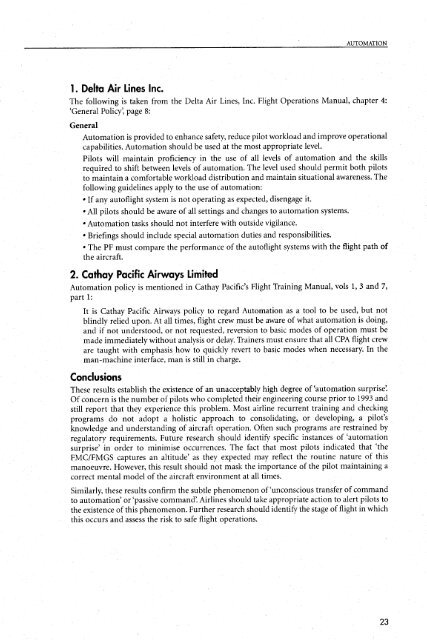Advanced Technology Aircraft Safety Survey Report - Australian ...
Advanced Technology Aircraft Safety Survey Report - Australian ...
Advanced Technology Aircraft Safety Survey Report - Australian ...
Create successful ePaper yourself
Turn your PDF publications into a flip-book with our unique Google optimized e-Paper software.
AUTOMATION<br />
1. Delta Air lines Inc.<br />
The following is taken from the Delta Air Lines, Inc. Flight Operations Manual, chapter 4:<br />
‘General Policy’, page 8:<br />
General<br />
Automation is provided to enhance safety, reduce pilot workload and improve operational<br />
capabilities. Automation should be used at the most appropriate level.<br />
Pilots will maintain proficiency in the use of all levels of automation and the skills<br />
required to shift between levels of automation. The level used should permit both pilots<br />
to maintain a comfortable workload distribution and maintain situational awareness. The<br />
following guidelines apply to the use of automation:<br />
If any autoflight system is not operating as expected, disengage it.<br />
All pilots should be aware of all settings and changes to automation systems.<br />
Automation tasks should not interfere with outside vigilance.<br />
Briefings should include special automation duties and responsibilities.<br />
The PF must compare the performance of the autoflight systems with the flight path of<br />
the aircraft.<br />
2. Cathay Pacific Airways Limited<br />
Automation policy is mentioned in Cathay Pacific’s Flight Training Manual, vols 1, 3 and 7,<br />
part 1:<br />
It is Cathay Pacific Airways policy to regard Automation as a tool to be used, but not<br />
blindly relied upon. At all times, flight crew must be aware of what automation is doing,<br />
and if not understood, or not requested, reversion to basic modes of operation must be<br />
made immediately without analysis or delay. Trainers must ensure thdt all CPA flight crew<br />
are taught with emphasis how to quickly revert to basic modes when necessary. In the<br />
man-machine interface, man is still in charge.<br />
Conclusions<br />
These results establish the existence of an unacceptably high degree of ‘automation surprise’.<br />
Of concern is the number of pilots who completed their engineering course prior to 1993 and<br />
still report that they experience this problem. Most airline recurrent training and checking<br />
programs do not adopt a holistic approach to consolidating, or developing, a pilot’s<br />
knowledge and understanding of aircraft operation. Often such programs are restrained by<br />
regulatory requirements. Future research should identify specific instances of ‘automation<br />
surprise’ in order to minimise occurrences. The fact that most pilots indicated that ‘the<br />
FMC/FMGS captures an altitude’ as they expected may reflect the routine nature of this<br />
manoeuvre. However, this result should not mask the importance of the pilot maintaining a<br />
correct mental model of the aircraft environment at all times.<br />
Similarly, these results confirm the subtle phenomenon of ‘unconscious transfer of command<br />
to automation’ or ‘passive command’. Airlines should take appropriate action to alert pilots to<br />
the existence of this phenomenon. Further research should identify the stage of flight in which<br />
this occurs and assess the risk to safe flight operations.<br />
23
















